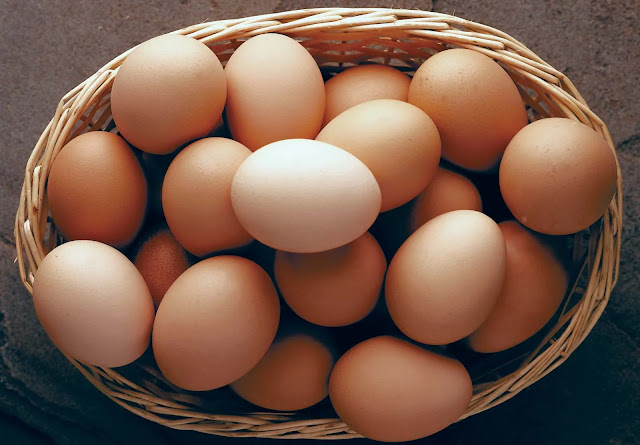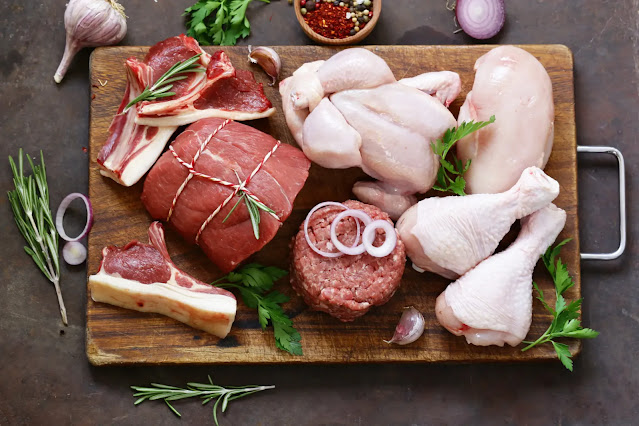50 Super Healthy Foods to eat
Today, through our blog Vlogvaults, we want to give information about 50 Super Healthy Foods. Consumption of various types of nutritious foods can play an important role in promoting your overall well-being. Including fruits, vegetables, nuts, seeds and lean proteins in your diet can help you achieve a colorful, versatile and healthy meal plan.
Here's a collection of 50 super healthy foods options to consider:
1-6: Fruits and Berries | 50 Super Healthy Foods
Fruits and berries are renowned for their health benefits, are delicious, and are easy to incorporate into your diet without extensive preparation.
Apples: They contain fiber, vitamin C, and lots of antioxidants, making them a filling and ideal snack between meals.
Avocado: Rich in healthy fats, avocado is creamy, delicious, and rich in fiber, potassium, and vitamin C. They can replace mayonnaise in salads or garnish your breakfast toast.
Bananas: A powerhouse of potassium, bananas also provide vitamin B6 and fiber. They are a convenient, portable option.
Blueberries: Known for their deliciousness and high antioxidant content.
Orange: Celebrated for its vitamin C, fiber and antioxidant properties.
Strawberries: These low-carb, low-calorie gems are packed with vitamin C, fiber, and manganese, making for a delicious dessert.
Other Healthy Fruits
Additional nutritious options include cherries, grapes, grapefruit, kiwi, lemons, mangoes, melons, olives, peaches, pears, pineapple, plums and raspberries.
7. Eggs
Eggs are a nutritional powerhouse and have been reevaluated as a valuable protein source, shedding their former cholesterol-related stigma. They offer a variety of benefits.
8-10: meat | 50 Super Healthy Foods
In small amounts, lean, unprocessed meat contributes to a balanced diet.
Lean Beef: A top source of protein and highly absorbable iron.
Chicken Breast: Low in fat and calories but rich in protein and nutrients.
Lamb and mutton: These meats, which are often grass-fed, contain more omega-3 fatty acids than omega-6.
11-15: Nuts and seeds | 50 Super Healthy Foods
Nuts and seeds, although rich in calories, can aid heart health and weight management. They require minimal preparation and can add delightful texture to a variety of dishes, so be warned to avoid them if you have a nut allergy.
Almonds: Famous for their vitamin E, antioxidants, magnesium and fiber content.
Chia Seeds: Rich in nutrients, these seeds contain abundant amounts of fiber, magnesium, manganese, calcium, and many other nutrients.
Coconut: Provides fiber and medium-chain triglycerides (MCTs).
Macadamia Nuts: A tasty option with higher monounsaturated fats and lower omega-6 fatty acids than most other nuts.
Walnuts: Rich in fiber, vitamins, minerals and are a perfect salad enhancer when combined with feta cheese.
16. Brazil Nuts | 50 Super Healthy Foods
These nutrient-rich nuts are prized for their smooth texture, supporting thyroid function, and providing essential selenium.
17-26: Vegetables | 50 Super Healthy Foods
Calorie for calorie, vegetables are nutritional powerhouses, providing plenty of nutrients. Including a variety of vegetables in your diet ensures a wide range of benefits.
Asparagus: Low in carbs and calories, asparagus is a vitamin K-rich vegetable.
Bell peppers: Available in a variety of colors, they provide a crunchy, sweet, antioxidant-rich source of vitamin C.
Broccoli: A versatile cruciferous vegetable rich in fiber, vitamins C and K and a respectable protein content among vegetables.
Carrots: A sweet, crunchy root vegetable rich in nutrients, including fiber, vitamin K and carotene antioxidants.
Cauliflower: A versatile cruciferous vegetable suitable for a variety of culinary applications.
Cucumber: A refreshing, low-calorie snack composed primarily of water, minor vitamin K and other nutrients.
Garlic: A healthy and delicious addition to both salads and cooked dishes, providing antioxidant and antimicrobial effects.
Kale: Rich in fiber, vitamins C and K and other nutrients, which provides a satisfying flavor to salads and dishes.
Onions: Known for their strong flavor, they contain bioactive compounds with potential health benefits.
Tomato: Although technically a fruit, tomatoes are a delicious delight containing potassium and vitamin C.
More healthy vegetables
Additional vegetable options include artichokes, Brussels sprouts, cabbage, celery, eggplant, leeks, lettuce, mushrooms, radishes, squash, Swiss chard, collard greens, turnips and zucchini.
27-32: Fish and Seafood | 50 Super Healthy Foods
Fish and seafood, rich in omega-3 fatty acids and iodine, may be valuable for heart and brain health.
Salmon: A delicious, nutrient-rich oily fish that provides protein, omega-3 fatty acids and vitamin D.
Sardines: These small, oily fish are rich in nutrients, including calcium and vitamin D.
Shellfish: Nutrient-rich choices like clams, mollusks and oysters make a delicious, light meal when obtained from reputable providers.
Shrimp: A low-fat, high-protein crustacean, shrimp provide selenium and vitamin B12.
Trout: Similar to salmon, trout is another delicious freshwater fish.
Tuna: Low in fat and calories, tuna is rich in protein, an ideal choice to increase protein intake while maintaining calorie control. Choose responsibly sourced, low-mercury varieties.
33-35: grains | 50 Super Healthy Foods
Rich in healthy carbohydrates, whole grains provide essential micronutrients, fiber and energy for your body.
Brown rice: A better alternative to white rice, brown rice provides fiber, vitamin B1 and magnesium.
Oats: Provides nutrients and beneficial beta glucan, which helps lower cholesterol and promote gut health.
Quinoa: This delicious grain has a high fiber and magnesium content, making it a great source of plant-based protein.
36-37: Bread | 50 Super Healthy Foods
Whole grain bread, rich in fiber and nutrients, is better than highly processed white bread.
Ezekiel Bread: Made with organic sprouted whole grains and beans.
Homemade Low-Carb and Gluten-Free Bread: For those wanting a low-carb or gluten-free option, consider exploring homemade recipes to ensure quality and dietary preferences.
38-41: Legumes | 50 Super Healthy Foods
Legumes, excellent sources of plant-based protein, iron and fiber, may impact digestion and nutrient absorption. These effects can be minimized by proper soaking and preparation.
Green Beans: Also known as string beans, these raw common beans can be enjoyed as a side dish or salad ingredient.
Kidney beans: Rich in fiber and various vitamins and minerals, kidney beans should be cooked to eliminate their inherent toxicity.
Lentils: Another popular legume, lentils provide abundant fiber and plant-based protein.
Peanuts: Despite being a legume, peanuts are both delicious and nutritious, containing antioxidants and potential weight management benefits. Caution is advised when consuming peanut butter, especially regarding calorie intake.
42-44: Dairy | 50 Super Healthy Foods
Dairy products, for those who tolerate them, provide abundant amounts of essential nutrients.
Cottage cheese: A little cottage cheese provides the same amount of nutrients as a cup of milk, and it serves as a delicious protein option. Choose less processed cheese varieties.
Dairy milk: Rich in vitamins, minerals, protein, and calcium, with some research suggesting potential cardiovascular benefits.
Yogurt: Made from milk fermented with live probiotic bacteria, yogurt shares many of the health benefits with milk along with the added benefits of friendly probiotics.
45-46: Fats and Oils | 50 Super Healthy Foods
A diet rich in unsaturated fats and oils is considered healthy.
Extra-virgin olive oil: Famous for its heart-healthy monounsaturated fats and strong antioxidant content.
Coconut oil: While it contains the same medium-chain triglycerides (MCTs) as olive oil, it has been linked to an increase in LDL (bad) cholesterol, requiring moderation in use.
47-48: Tuber | 50 Super Healthy Foods
Tubers, often called root vegetables, provide essential nutrients.
Potatoes: Providing potassium, vitamin C and a range of nutrients, potatoes, especially when eaten with the peel, contribute to satiety and potential weight management.
Sweet Potatoes: Rich in antioxidants, beta carotene and vitamin A, sweet potatoes can be baked, mashed or added to various dishes.
49. Apple Cider Vinegar
Apple cider vinegar may aid in blood sugar regulation after meals, making it a useful addition to salads and meals.
50. Dark Chocolate
Dark chocolate contains flavonoid antioxidants, which are potentially beneficial for cholesterol management and heart health. However, according to the American Heart Association, its health benefits generally derive from moderate consumption for pleasure rather than as a primary source of nutrition.
In short, whether your goal is to change your diet or simply add variety to your meals, you can easily incorporate many of these foods into your daily routine. These 50 super healthy foods options not only make satisfying breakfasts, but they also provide essential nutrients, some of which are potentially helpful in weight management.




%20(1).webp)












0 Comments:
Post a Comment
Subscribe to Post Comments [Atom]
<< Home